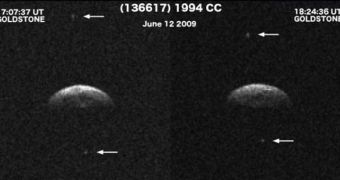Only a couple of months ago did astronomers manage to discover a new member of the triple-asteroid class, when they realized that the Near-Earth Object (NEO) known as 1994 CC actually was made up of three pieces. In addition to the central rock, which is the largest of them all, two other bodies, with much smaller diameters, orbit around it. The object encountered the Earth within 2.52 million kilometers (1.56 million miles) on June 10, 2009, ScienceDaily informs.
As far as NEO populations go, this is only the second triple-system found to date. The main asteroid, around which the other two revolve, is about 700 meters (2,300 feet) in diameter, whereas the other may be as small as 50 meters (164 feet). The 1994 CC system was very little known before it made the recent fly-by, astronomers say. It was picked up via radar imaging by the NASA Goldstone Solar System Radar on June 12. In charge of the study were NASA Jet Propulsion Laboratory (JPL) experts Marina Brozovic and Lance Benner.
According to them, the next fly-by that 1994 CC will perform next to the Earth will take place in 2074, when it passes at an estimated distance of about 2.5 million kilometers (1.6 million miles) away from our planet. Analysts say that we have little to fear from the triple system, as the chances of it being knocked off course and driven into the Earth are fairly slim and close to negligible. The same experts also add that out of the hundreds of NEO that have thus far been cataloged via radar imaging, less than 1 percent are triple systems.
The recent fly-by offered astronomers at NASA and elsewhere the possibility to work together in assessing the threat that the triple-system brought forward. In addition to the data collected by the Goldstone Solar System Radar, experts in Puerto Rico, at the Arecibo Observatory, also took measurements of their own, under the supervision of Mike Nolan, the director of the institution. When the two sets of readings are combined, astronomers will have a powerful tool to help them determine the orbit and physical properties of 1994 CC.

 14 DAY TRIAL //
14 DAY TRIAL //